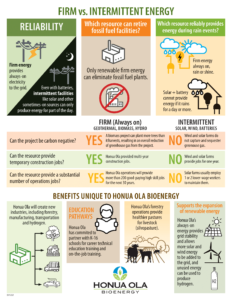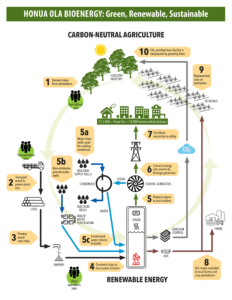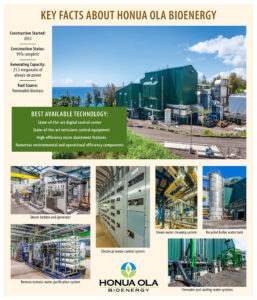THE NEED FOR
Hawai‘i is the most oil-dependent state in the country. Most of the state’s electricity is generated by petroleum oil, and ninety-nine percent of the crude oil consumed in Hawai‘i comes from foreign sources. This dependence makes the cost of living for our residents subject to pricing fluctuations in faraway places which we have no control, and comes with grave environmental costs.
Honua Ola Bioenergy will use locally-grown and harvested commercial biomass to make available 21.5 megawatts of renewable energy in a newly refurbished, reconstructed plant that once burned bagasse and then coal. This renewable, clean source of energy will become an important part of Hawaiʻi Island’s renewable energy portfolio, adding predictability and firm stability to complement solar, wind, hydro, and ocean thermal energy generation.
Honua Ola will help Hawai‘i reach its goal to produce all electrical power needs from renewables by 2045. Once the facility begins operation, it will have the ability to power approximately 14,000 households with renewable energy.
Honua Ola’s generation potential is enough to provide about 14 percent of HELCO’s capacity. Honua Ola will displace the output of oil-fired generating units, eliminating about 250,000 barrels of imported oil per year.
THE NEED FOR
Renewable Biomass
Biomass is a plant or plant-based material used to generate electricity. This sustainable fuel source can be grown as a renewable crop, to produce power and replace fossil fuels such as coal, oil or natural gas.
During Hawai‘i’s sugar production days, biomass powered the islands’ sugar plantations. After sugar was extracted, bagasse (the leftover leaves and crushed stalk) was used to make steam to turn a turbine and produce electricity. Excess power was sold to the local utility. As sugar mills shut down, biomass feedstock and, therefore, power generation declined. However, today’s demand for firm, low-cost, renewable power coupled with an abundant, sustainable supply of commercially managed biomass feedstock means facilities like Honua Ola are emerging as a vital part of Hawai‘i’s long-term energy equation.




